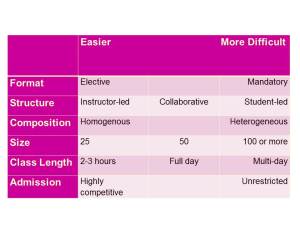
Here’s what the ultimate teaching challenge might look like…and in the future it may be the rule rather than the exception
A new book, Motivational Interviewing in Groups (Wagner and Ingersoll) outlines motivational approaches and strategies in group facilitation. While the book’s emphasis is on clinical practice, the principles and applications are also relevant to education settings.
The book’s authors present a table illustrating different types of group format, structure, composition, size, length and admission arranged along a continuum of difficulty (for facilitators) from easier to harder:

This looks different for educational groups, but the essentials still apply. Here is my modification of Wagner and Ingersoll’s framework calibrated for teaching and learning:

In other words:
Elective courses are easier to teach than mandatory courses. Students generally take electives out of interest, as opposed to being forced to take mandatory courses. Teaching students content that someone else thinks they ought to know is tougher than content in which they’re already interested.
Instructor-led courses presuppose a “script” (i.e. lesson plan), versus collaborative or student-led curricula. Paragogical approaches posit peer-to-peer learning and individual autonomy, and demand a proportionately higher level of finesse and facilitation.
Classes where students share more similarities than differences can be easier to work with than heterogeneous class compositions. For example, students who differ widely in age, ability or pre-existing knowledge and skills present more of a challenge in ensuring that all learning needs are met, and establishing an inclusive, cohesive and positive community of learning. Of course diversity, including culture, sex, gender and lived experience, enriches everyone’s learning exponentially – but demands artful facilitation on our part.
Student engagement and interactivity are more straightforward in classes of 25 or less. As class size increases so does the challenge of promoting opportunities for practice and integration of knowledge and skills.
It’s easier to keep peoples’ interest and attention for a single class of 2 or 3 hours than it is for a whole day or for multiple days. The latter demands both a varied menu of instructional strategies as well as formidable stamina (on the part of the instructor and the students).
Strict and highly competitive admission criteria can yield the “cream of the crop” of high-achieving and highly motivated learners. On the other hand, classes where admission is unrestricted means addressing the needs of the best and the brightest alongside those with academic struggles and other challenges.
Like any framework, this conceptualization tends to oversimplify and blur the many complexities and nuances of artful classroom teaching. Real life is always messier than the manual (if there even is a manual). But in general, teaching a mandatory class using a student-led curriculum, among a highly diverse cohort of 100 students or more, over a multi-day course that is freely open to all could well represent the ultimate teaching challenge.
We haven’t added the layer of classroom-based versus online teaching and learning, but does this scenario represent what may well be future of higher education…MOOC 2.0?











